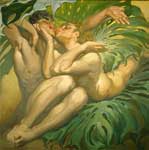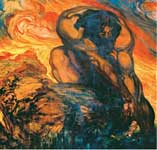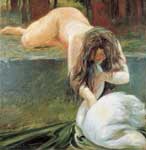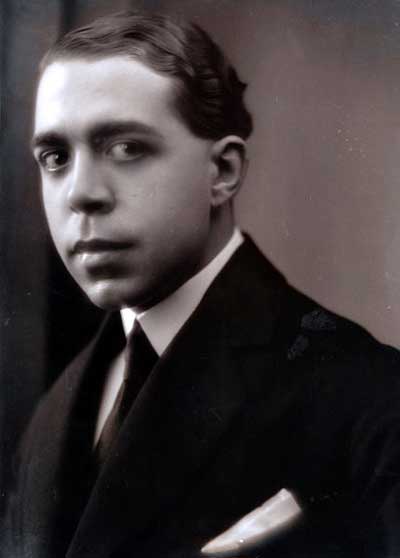Paintings

Joselito

La Primavera

Rose and Silver

Hercules

Leda
Nestor Martin Fernandez de la Torre (Las Palmas de Gran Canaria, Canary Islands, February 7, 1887 - February 6, 1938), Canary Island painter who participated widely symbolist currents and European Modernism, leaving a work considered, with one voice by experts, an essential for detailed these artistic movements.
[] Biography
Nestor began to develop his artistic vocation in Gran Canaria when he was a child, making his first drawings with just seven years of age, while studying at the Colegio de San Agustin, where he received drawing lessons from Nicolas Massieu. Before the end of the nineteenth century, in 1899, received his first artistic guidance of his first teacher, seascape and Spanish paisjista Meifrén Elisha, in getting his first painting. With fifteen years, Nestor traladaría to Madrid, where Rafael Hidalgo de Caviedes welcomes you as a disciple, to continue his studies and, from 1904, would go to Europe (Paris, Brussels, Ghent, Bruges and London) to perfect his technique. These were the years during which he lived in Paris who finished chiseling the artist, giving his powerful decorative reputation it acquired with its ornamental intervention in public buildings and the design of theater sets and clothing.
In Barcelona organized his first exhibition in 1908 at the Equestrian Circle, a collection of retratoscon influence of the great English portrait painters, but endowed with the personal touch of Nestor, with a wealth of detail and elegance that captivates by its palette and its idealization models. The following year, 1909, presented in the lounge of Barcelona Parès four decorative panels for the Hall of Feasts of the Tibidabo, inspired by the poems of Verdaguer, L'Atlàntida and Canigou. Some important Garden of the Hesperides and Gentile carried by floodwaters. A few years later out in the Catalan Fayans portrait of Enrique Granados and Berenice, and various drawings to pen in 1911. Back in London, made etchings, The Garrotín and the Macarena, for which he received the first prize in the Municipal School London, where then prepared several exhibitions, so does Paris and Madrid. In these etchings, Nestor often resorted to the representation of writhing bodies covered with shawls and lace.
In its first foray into the performing arts, Nestor would design the sets and costumes for the play El Amor Brujo by Manuel de Falla, which premiered in Madrid in 1915. A few years earlier, in 1912, the artist would be appointed to the Union Internationale des Beaux Arts et des Lettres de Paris, in 1928 moving his studio from Madrid to Paris. From here you would attend various exhibitions in Europe and in several American cities, first in Buenos Aires in 1918. In 1924 he presented the first part of his work life, the Poem of the Atlantic in the Palace Library and the Municipal Museum of Madrid. That same year he exhibited his work in Venice.
Great colorist and decorator, Nestor, in essence, is a painter of portraits and compositions of great fantasy backgrounds, involved in textiles and architecture of a great finish. The artist also traveled to Africa by the Spanish colonies and returned the Canaries in the thirties. On the islands spent his last years, finally settled his studio in Gran Canaria, where he began his stage treble in 1934, and made the decoration of the Casino de Tenerife and the Teatro Perez Galdos in Las Palmas de Gran Canaria, his hometown, where it ended installing the museum of his work years later.
Nestor died prematurely when he was about to turn 51. With his death, left unfinished Poem of the Earth and Air and sketches Poem Poem of Fire, which planned to make in addition to their great work. His funeral was a social event at the time, bringing together a large crowd of people.
On July 18, 1956 was opened in the Pueblo Canario, architectural complex conceived in the last years of his life, the Nestor Museum, art gallery which houses much of his work.
Artistic Production
Pueblo Canario, detail.
Nestor is one of the best known painters canaries outside the islands by their popularity and worth of his work. This falls within the modernist movement, which is considered as the main representative in the Canary painting, stressing in their creations the use of light makes the artist, painting mainly in the series Epic of the Elements. Nestor was mainly decorative painter conception. In this sense he collaborated with his brother, the architect Miguel Martin Fernandez de la Torre, in some of its construction projects, such as the Teatro Pérez Galdós or the Pueblo Canario in Las Palmas de Gran Canaria, and the Parador de Cruz de Tejeda. In the latter two embodiments, Nestor completely abandoned modernist taste for something like the "reconstruction of the canary" or what would become known, neocanario style.
Nestor conceived two pictorial series that reflect their attachment to the aesthetics of modernist symbolism: the Epic Poem of the Sea and Earth. These series are only part of the ambitious poem of the Elements, a tribute to nature Canaries had planned to make and that his early death cut short. Before him, no Canarian artist had dared to make such vast mural decorations. An example which ran for the Teatro Perez Galdos in Las Palmas or the Casino de Santa Cruz de Tenerife.
Selection of works
Nestor canvases at the Teatro Perez Galdos.
Poem of the Elements
Pictorial project that the artist was developing throughout your life. Series consists of the Poem of the Atlantic (or Poem of the Sea), and the unfinished poem of Earth, as well as two other collections, Poem Poem of Fire and Air, which failed to start.
Marina (1900)
Nestor's first work, a seascape, the fruit of his first contacts with the art of the hand of Elisha Meifrén seascape.
Adagio (1903)
Work done in his youth that announces the engagement of Nestor with symbolism. Was presented at the special exhibition of Fine Arts Circle of Madrid where he earned a mention from the jury for its representation of the classical myth of Leda and the Swan, where Zeus, Leda eager to make her lover, mutates into a swan to approach her and possess. The painting shows the moment in which Leda, nude, lying by the pool, sensually stroking the animal's neck, in a scene full of eroticism that does not become obscene. Diagonal composition in which Nestor uses a palette of murky brown and brown to get all the light from the scene falls on the protagonist's bare chest and intensifying the black plumage of the bird.
Self-Portrait (1904)
Calle Mayor of Madrid (1904)
His early work, which shows the influence of his teachers, Elisha Meifrén and Rafael Hidalgo de Caviedes.
The White Lady (1907)
Nestor first Symbolist painting, painted during his stay in Barcelona.
Sister of the Roses (1908)
Represents the continuation of his symbolist period. It is a full-length portrait in which the haughty attitude of the woman comes to hooking up with a rigid composition, devoid of motion, in which the intense reds and oranges flood the canvas.
Epithalamion (1909)
Work that was selected to represent the Spanish art at the Exposition Universelle et Intenationale Brussels. Self-portrait in which the artist is depicted wearing the Eastern magnificence of a prince. The orginal title of painting was The Marriage of Prince Nestor.
Granado (undated)
Portrait.
The boy archer (1912)
Work in which the confluence of three different sources of inspiration: the classical myth of Eros, Greek god of love and passion embroidered fabrics Manila (Philippines), and the admiration he felt for Nestor European Baroque, represented by the source Plaza de Santo Domingo (Las Palmas de Gran Canaria), notable example of this artistic style in the Canary Islands.
Poem of the Atlantic
Nestor Joint canvases made between 1913 and 1924 in the development of which interprets the sea conditions at different times of day. The artist uses a technique of fillings and glazes with which to obtain a realistic representation of the ocean, carrying a painting very much in the early twentieth-century Modernism, which also shows an interesting color range by using it makes the color, softening, feathering or exalting him strongly. Also, in each of the works in the series, Nestor plasma a kind of mythology of adolescent bodies, manly ambiguously that swim, rest or make opposition to the waves and sea creatures that are drawn in part from the fact and leaves from the fiction of the artist. Part of the collection Poem of the Elements, vital project of the artist. He also called Song of the sea, consists of eight tables: the midday and afternoon (1917-1918), Evening, Low Tide, High Tide, Rest and Stormy (1918-1924).
The ampor sorcerer (1915)
Making the sets for the ballet by Manuel de Falla, whose work was premiered in Madrid.
Teatro Perez Galdos
Main article: Teatro Perez Galdos The artist helped his brother Miguel, who led the project to rebuild the Coliseum after a fire. Nestor took, between 1926 and 1928, the interior decoration of the theater, and its most notable achievements on canvas paintings of Saint-Saëns room and allegories, also on canvas, Apollo and the Muses and The Song and Dance, in the main room. Theirs are also the stained-glass windows, the design of the lamps and the shield of the city allegorical sewing in the curtain.
The Candil Fandango (1927)
Costume design and scenery for play.
Visions of Gran Canaria (1928-1934)
Pictorial campaign, which called local color, which enhances the canariedad with a view to a future tour.
Triana (1929)
Making scenery and costumes for this work Albéniz.
Salome (1929)
Adapting the work of Strauss directed by Maria Kousnetzoff for Nestor designed the sets.
Don Giovanni (1931)
Mary Kousnetzoff commissions the scenery and costumes for the performance of this work by Mozart.
Madame Moss (1931)
Portrait.
Madame Bocher (1931)
Portrait.
Casino de Santa Cruz de Tenerife (1932)
Main article: Santa Cruz Casino Design murals.
Poem of the Earth
Work that the artist began in 1934 and left unfinished after his death. Poem of the Atlantic was complementary to and integrated within the collection of the Poem of the Elements. It consists of eight pieces, representing the four seasons and four times of day. The series are the canvases Orto, Midi, Vespero, Night, Spring, Summer, Autumn and Winter, all dated between 1934 and 1938, which, upon reaching his death, Nestor left at different times run from mere sketches to work completed, or nearly so.
Sketches of the Parador de Cruz de Tejeda (1937)
Main article: Parador de Cruz de Tejeda collaboration with his brother Michael in the building design and interior decoration. As with the sketches he made for the Pueblo Canario, who years later would be materialized with great fidelity, these sketches are animated by the vividness of the typical scenes that are represented in them and the colors of the inks used. Nestor did not just make a few sketches technically cool, but in them, fried of his imagination, embodied and completed buildings and carrying out the function for which they were to be allocated.
Sketches for the Pueblo Canario (1937)
Main article: Pueblo Canario Wishing Nestor settling in Gran Canaria, sought a place that could accommodate his paintings. Thus, in 1937 drew the first sketches of Pueblo Canario, would start up in under the direction of his brother Miguel Martin Fernandez de la Torre in 1939. The Pueblo Canario is an expression of artistic genius of the brothers. It consists of a square irregular closed for several buildings who set a typical corner. It also has a chapel, reminiscent of that once was located in the same place. The museum houses his work holds the rising side of the complex and opened in 1956.
References
Notes
↑ According to the author's introductory text on the website of the museum that bears his name.
Literature
German Hernandez, Saro (1991). The painter Néstor Martín Fernández de la Torre: (1887-1938). Las Palmas de Gran Canaria Cabildo of Gran Canaria. ISBN 84-85628-80-2.
Almeida Cabrera, Pedro (1991). Nestor: Nestor Martin Fernandez de la Torre. Las Palmas de Gran Canaria, Canary Islands Government, Deputy Ministry of Culture and Sports. ISBN 84-7947-052-6.
[Pop Culture Center Canaria] (2005). The Encyclopedia of canaries illustrious (1 st ed., [The Great Library of the Canary Islands] edition). [La Laguna (Tenerife)]: Center for Popular Culture Canaria. ISBN 84-7926-516-7.
Piqué Herrera, Alfredo / Santana, Lazarus (1976). Museums and monuments in the province of Las Palmas. Las Palmas de Gran Canaria Island Savings Fund. ISBN 84-7231-297-6.
See also
Nestor museum, art gallery which houses much of his work
Miguel Martin Fernandez de la Torre, architect and brother of the artist
Other embodiments
Teatro Perez Galdos
Pueblo Canario
Parador de Cruz de Tejeda
Casino in Santa Cruz
Painter

Néstor Martín-Fernández de la Torre
From Wikipedia. Text is available under the Creative Commons Attribution-ShareAlike License
